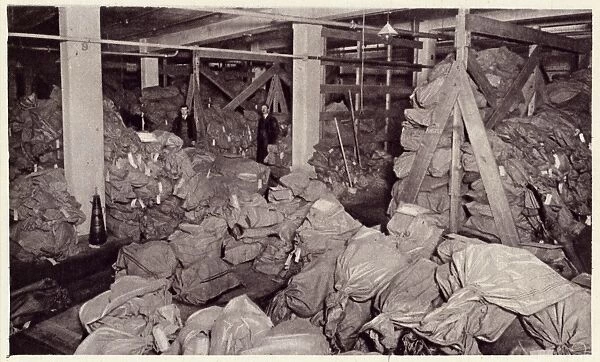Home > Historic > World War I and II > World War I
Postal censorship during World War I
![]()

Wall Art and Photo Gifts from Mary Evans Picture Library
Postal censorship during World War I
Photograph showing condemned goods taken from the mail and stored to await the decision of the Prize Court. Date: 1917
Mary Evans Picture Library makes available wonderful images created for people to enjoy over the centuries
Media ID 14312694
© Illustrated London News Ltd/Mary Evans
Censor Censorship Communication Contraband Control Correspondence Disguise Freedom Interception Letter Letters Limit Limitation Mail Office Postal Smuggling
EDITORS COMMENTS
This evocative photograph captures the intense postal censorship efforts during World War I, as condemned goods are carefully sorted and stored in a warehouse, awaiting the decision of the Prize Court. The year was 1917, and the First World War had reached its peak, with communication between the battlefronts and the home front becoming a critical lifeline for soldiers and their families. The image shows a scene of meticulous examination, as postal officials carefully sift through the confiscated items, searching for any contraband or materials that could potentially aid the enemy. The pile of parcels and letters, once filled with love, comfort, and essential supplies, now lay open, their contents exposed and scrutinized. The postal censorship process was a complex and intricate one, with letters and parcels subjected to rigorous inspection. The authorities were on the lookout for anything that could be considered a threat, from military intelligence to smuggled goods. Even the most innocuous items, such as foodstuffs or personal effects, could be deemed contraband if they were believed to have the potential to be used for nefarious purposes. The censorship process was a necessary evil, a limitation on the freedom of communication in the name of national security. The postal officials, often working long hours under immense pressure, were tasked with the responsibility of maintaining the security of the nation while ensuring that the essential flow of communication between the battlefronts and the home front was not disrupted. Despite the best efforts of the censors, however, some items still managed to slip through the cracks, often disguised in ingenious ways. The cat-and-mouse game between the censors and the smugglers added another layer of intrigue to the already complex and dynamic landscape of the First World War.
MADE IN AUSTRALIA
Safe Shipping with 30 Day Money Back Guarantee
FREE PERSONALISATION*
We are proud to offer a range of customisation features including Personalised Captions, Color Filters and Picture Zoom Tools
SECURE PAYMENTS
We happily accept a wide range of payment options so you can pay for the things you need in the way that is most convenient for you
* Options may vary by product and licensing agreement. Zoomed Pictures can be adjusted in the Cart.


